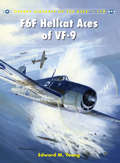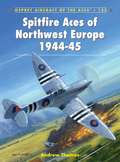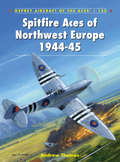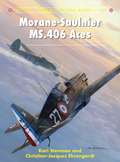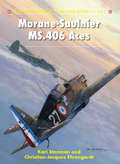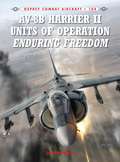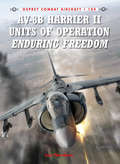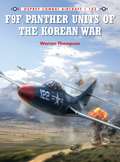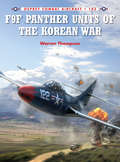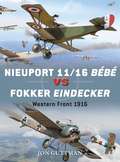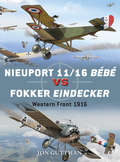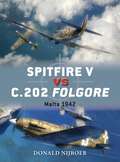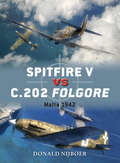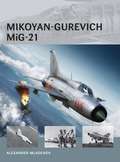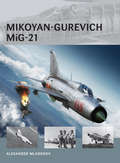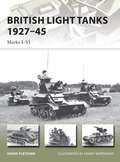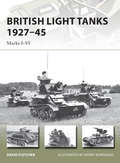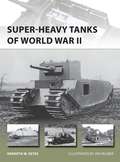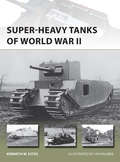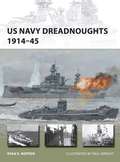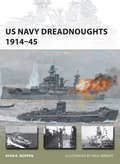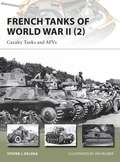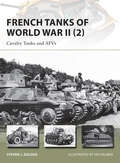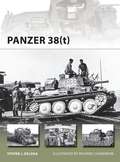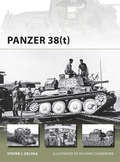- Table View
- List View
F6F Hellcat Aces of VF-9 (Aircraft of the Aces #119)
by Jim Laurier Edward M. YoungVF-9 was activated in March 1942 as part of Carrier Air Group (CAG) 9, one of the many air groups the US Navy was hurriedly forming in the aftermath of the Japanese attack on Pearl Harbor. Equipped with Grumman F4F Wildcats, VF-9 first saw combat during the Allied invasion of North Africa in November 1942, where the squadron engaged Vichy French fighters over Morocco. Returning to the United States, VF-9 became one of the first squadrons to receive the Grumman F6F Hellcat and to deploy on the USS Essex, the first of its class of fleet carriers that would form the backbone of the US Navy's Fast Carrier Task Force. VF-9, the Hellcat, and the Essex all entered combat in the fall of 1943. In the hands of the squadron's pilots, and with other Navy fighter squadrons, the Hellcat proved superior to the Imperial Japanese Navy's A6M Zero, which had heretofore been the world's premier carrier fighter plane.
Spitfire Aces of Northwest Europe 1944-45 (Aircraft of the Aces)
by Andrew Thomas Chris ThomasThis book traces the achievements of the pilots flying the iconic Spitfire in Northwest Europe, and examines how the steady technological improvements that were made throughout the Spitfire's service life improved its capabilities in the air. Based at airfields throughout southern England, Merlin engine Spitfires provided the bulk of the air cover for the D-Day landings and it was an RCAF Spitfire which claimed the first ever ME 262 jet kill. 36 colour profiles covering a broad spectrum of nationalities, units, pilots, theatres and markings complement thorough research throughout this comprehensive account of these crucial fighter aircraft.
Spitfire Aces of Northwest Europe 1944-45 (Aircraft of the Aces #122)
by Andrew Thomas Chris ThomasThis book traces the achievements of the pilots flying the iconic Spitfire in Northwest Europe, and examines how the steady technological improvements that were made throughout the Spitfire's service life improved its capabilities in the air. Based at airfields throughout southern England, Merlin engine Spitfires provided the bulk of the air cover for the D-Day landings and it was an RCAF Spitfire which claimed the first ever ME 262 jet kill. 36 colour profiles covering a broad spectrum of nationalities, units, pilots, theatres and markings complement thorough research throughout this comprehensive account of these crucial fighter aircraft.
Morane-Saulnier MS.406 Aces (Aircraft of the Aces #121)
by Chris Davey Kari Stenman Christian-Jacques EhrengardtThe MS.406 was an important aircraft not only because it was built in larger numbers than any other French fighter of the period, but also because it was the first modern fighter in the Armée de l'Air inventory. Although comparable to the British Hurricane and early models of the German Bf 109, it was outclassed when flown against the more powerful, and faster, Bf 109E. With little or no protection (no armour or self-sealing tanks), the MS.406 sustained heavy losses during the Battle of France. Too lightly armed, and fitted with unreliable weaponry, the French fighter struggled to down German bombers. It therefore comes as no surprise that only a dozen French pilots became fully fledged aces on the type during this period, despite the aircraft being present in significant numbers. However a score of pilots, who bagged their very first kills at the controls of the MS.406, fought on after the fall of France, flying Dewoitine D.520s, Spitfires and even Soviet Yak-3s to attain ace status against both Allied and Axis opponents.
Morane-Saulnier MS.406 Aces (Aircraft of the Aces #121)
by Chris Davey Kari Stenman Christian-Jacques EhrengardtThe MS.406 was an important aircraft not only because it was built in larger numbers than any other French fighter of the period, but also because it was the first modern fighter in the Armée de l'Air inventory. Although comparable to the British Hurricane and early models of the German Bf 109, it was outclassed when flown against the more powerful, and faster, Bf 109E. With little or no protection (no armour or self-sealing tanks), the MS.406 sustained heavy losses during the Battle of France. Too lightly armed, and fitted with unreliable weaponry, the French fighter struggled to down German bombers. It therefore comes as no surprise that only a dozen French pilots became fully fledged aces on the type during this period, despite the aircraft being present in significant numbers. However a score of pilots, who bagged their very first kills at the controls of the MS.406, fought on after the fall of France, flying Dewoitine D.520s, Spitfires and even Soviet Yak-3s to attain ace status against both Allied and Axis opponents.
AV-8B Harrier II Units of Operation Enduring Freedom (Combat Aircraft)
by Lon Nordeen Jim LaurierIn the 1970s the USMC bought the AV-8A Harrier from the UK whose VTOL capabilities allowed it to serve as a tactical aircraft that could deploy with Marine forces on amphibious assault ships and provide air cover and close air support from large deck aircraft carriers. Third in a trilogy on US Marine Corps Harrier IIs in combat, it will be the first volume to cover the whole story of the AV-8B's service employment during peacekeeping operations and then in Afghanistan. With profile artwork for all frontline AV-8B units detailing the unique colours and markings applied by each squadron, this volume presents the widest variety of first-hand accounts of AV-8B air operations and missions by pilots and ground forces involved in Operation Enduring Freedom published to date.
AV-8B Harrier II Units of Operation Enduring Freedom (Combat Aircraft #104)
by Lon Nordeen Jim LaurierIn the 1970s the USMC bought the AV-8A Harrier from the UK whose VTOL capabilities allowed it to serve as a tactical aircraft that could deploy with Marine forces on amphibious assault ships and provide air cover and close air support from large deck aircraft carriers. Third in a trilogy on US Marine Corps Harrier IIs in combat, it will be the first volume to cover the whole story of the AV-8B's service employment during peacekeeping operations and then in Afghanistan. With profile artwork for all frontline AV-8B units detailing the unique colours and markings applied by each squadron, this volume presents the widest variety of first-hand accounts of AV-8B air operations and missions by pilots and ground forces involved in Operation Enduring Freedom published to date.
F9F Panther Units of the Korean War (Combat Aircraft)
by Jim Laurier Warren ThompsonIn 1948 the USAF, Marine Corps and US Navy were concentrating on converting over to an all-jet force. When the Korean War started in June 1950, the USAF had built up a sizable jet force in the Far East, while the US Navy was in the early stages of getting F9F Panthers operational as replacements for its piston-engined F8F Bearcats. At about this time, the Marine Corps had also begun using the Panthers in limited numbers. Operating from aircraft carriers off the Korean coast, F9Fs helped stop the North Korean invasion within two weeks of the communists crossing the 38th Parallel. The Panthers, escorting carrier-based AD Skyraiders and F4U Corsairs, penetrated as far north as Pyongyang, where they bombed and strafed targets that the North Koreans thought were out of range. The Panthers also took the battle all the way to the Yalu River, long before the MiG-15s became a threat. The F9F's basic tasking was aerial supremacy and combat air patrols, but they also excelled in bombing and strafing attacks.
F9F Panther Units of the Korean War (Combat Aircraft)
by Jim Laurier Warren ThompsonIn 1948 the USAF, Marine Corps and US Navy were concentrating on converting over to an all-jet force. When the Korean War started in June 1950, the USAF had built up a sizable jet force in the Far East, while the US Navy was in the early stages of getting F9F Panthers operational as replacements for its piston-engined F8F Bearcats. At about this time, the Marine Corps had also begun using the Panthers in limited numbers. Operating from aircraft carriers off the Korean coast, F9Fs helped stop the North Korean invasion within two weeks of the communists crossing the 38th Parallel. The Panthers, escorting carrier-based AD Skyraiders and F4U Corsairs, penetrated as far north as Pyongyang, where they bombed and strafed targets that the North Koreans thought were out of range. The Panthers also took the battle all the way to the Yalu River, long before the MiG-15s became a threat. The F9F's basic tasking was aerial supremacy and combat air patrols, but they also excelled in bombing and strafing attacks.
Nieuport 11/16 Bébé vs Fokker Eindecker: Western Front 1916 (Duel)
by Jim Laurier Jon Guttman Mark PostlethwaiteThe appearance in July 1915 of the Fokker E I heralded a reign of terror over the Western Front that the Allies called the 'Fokker Scourge'. The French Nieuport 11 was one type desperately thrown into action to counter the Fokkers. The swirling dogfights between this fighter – and its more powerful but more unwieldy stablemate, the Nieuport 16 – and a succession of improved Fokkers, the E II, E III and E IV, came to symbolise air combat in World War I. This book gives a detailed look at the developmental history of the fighters, contrasting the interrupter gear-equipped Fokker with the more improvised solution incorporated in the Nieuport – a machine gun fitted to the upper wing to avoid the propeller entirely. The Germans went on to abandon the monoplane in favour of a new and deadly generation of biplane fighters, based on the lessons learned from these vicious engagements and influenced by the success of the French Nieuport.
Nieuport 11/16 Bébé vs Fokker Eindecker: Western Front 1916 (Duel #59)
by Jim Laurier Jon Guttman Mark PostlethwaiteThe appearance in July 1915 of the Fokker E I heralded a reign of terror over the Western Front that the Allies called the 'Fokker Scourge'. The French Nieuport 11 was one type desperately thrown into action to counter the Fokkers. The swirling dogfights between this fighter – and its more powerful but more unwieldy stablemate, the Nieuport 16 – and a succession of improved Fokkers, the E II, E III and E IV, came to symbolise air combat in World War I. This book gives a detailed look at the developmental history of the fighters, contrasting the interrupter gear-equipped Fokker with the more improvised solution incorporated in the Nieuport – a machine gun fitted to the upper wing to avoid the propeller entirely. The Germans went on to abandon the monoplane in favour of a new and deadly generation of biplane fighters, based on the lessons learned from these vicious engagements and influenced by the success of the French Nieuport.
Spitfire V vs C.202 Folgore: Malta 1942 (Duel)
by Jim Laurier Gareth Hector Donald NijboerThe inability of the Italians and Germans to invade Malta proved decisive for Allied victory in the Mediterranean during World War II, as the islands provided the Allies with a base from which to project air power. Early Italian efforts to pound the islands into submission were supplemented by major German forces from January 1942 and in a few weeks the situation for the defenders reached a critical stage; in response, in March 1942 the first Spitfires were delivered to Malta. Throughout the summer C.202s fought over Malta, escorting tiny formations of Cant Z.1007s, SM.79s and Ju 88s. The fighting subsided in August and September, but grew in strength with the arrival of more C.202s. In October the Regia Aeronautica could muster three Gruppi with a total of 74 C.202s. For ten days the Italians pressed a relentless attack before attrition brought the offensive to a halt. Throughout the bombing campaign the British were able to supply Malta with ever increasing numbers of Spitfires.
Spitfire V vs C.202 Folgore: Malta 1942 (Duel #60)
by Jim Laurier Gareth Hector Donald NijboerThe inability of the Italians and Germans to invade Malta proved decisive for Allied victory in the Mediterranean during World War II, as the islands provided the Allies with a base from which to project air power. Early Italian efforts to pound the islands into submission were supplemented by major German forces from January 1942 and in a few weeks the situation for the defenders reached a critical stage; in response, in March 1942 the first Spitfires were delivered to Malta. Throughout the summer C.202s fought over Malta, escorting tiny formations of Cant Z.1007s, SM.79s and Ju 88s. The fighting subsided in August and September, but grew in strength with the arrival of more C.202s. In October the Regia Aeronautica could muster three Gruppi with a total of 74 C.202s. For ten days the Italians pressed a relentless attack before attrition brought the offensive to a halt. Throughout the bombing campaign the British were able to supply Malta with ever increasing numbers of Spitfires.
Mikoyan-Gurevich MiG-21 (Air Vanguard #14)
by Adam Tooby Alexander MladenovThe MiG-21 (NATO reporting name Fishbed) firmly holds the title of the world's most widely built and used jet fighter, with more than 10,000 units rolling off the lines of three plants in the former Soviet Union. The type was also built under license in India and Czechslovakia, and without license in China until the late 2000s. Designed as a Mach-2 light tactical fighter, its original prototype, the Ye-6/1, was first flown in 1958. The first production variant of the type, designated the MiG-21F, appeared in 1960 and its improved sub-variant, the MiG-21F-13 (Type 74, NATO reporting name Fishbed-C), was made available for export by 1961. It was a simplified daytime short-range, clear-weather interceptor and tactical fighter.
Mikoyan-Gurevich MiG-21 (Air Vanguard #14)
by Adam Tooby Alexander MladenovThe MiG-21 (NATO reporting name Fishbed) firmly holds the title of the world's most widely built and used jet fighter, with more than 10,000 units rolling off the lines of three plants in the former Soviet Union. The type was also built under license in India and Czechslovakia, and without license in China until the late 2000s. Designed as a Mach-2 light tactical fighter, its original prototype, the Ye-6/1, was first flown in 1958. The first production variant of the type, designated the MiG-21F, appeared in 1960 and its improved sub-variant, the MiG-21F-13 (Type 74, NATO reporting name Fishbed-C), was made available for export by 1961. It was a simplified daytime short-range, clear-weather interceptor and tactical fighter.
British Light Tanks 1927–45: Marks I–VI (New Vanguard)
by Henry Morshead David FletcherThis is the definitive study of British light tanks of the Second World War. The author draws upon a vast and comprehensive body of archival information and research to explore their technical characteristics and combat performance. The title focuses largely on the very widely used Mark VI, but also covers all the variants that preceded it. The type was truly ubiquitous, equipping the British Army in France, the Western Desert regions, Norway, Sumatra, Persia and India. This book chronicles various experiments and improvisations carried out on the design of these tanks. It ends with coverage of the final model, the Mark VIC, and details of the experimental Lloyd airborne light tank of 1942, which has a number of features in common with the better-known Vickers-Armstrongs designs. Augmented by original photographs and technical drawings, this title is essential for anybody interested in the development of British armoured vehicles.
British Light Tanks 1927–45: Marks I–VI (New Vanguard)
by Henry Morshead David FletcherThis is the definitive study of British light tanks of the Second World War. The author draws upon a vast and comprehensive body of archival information and research to explore their technical characteristics and combat performance. The title focuses largely on the very widely used Mark VI, but also covers all the variants that preceded it. The type was truly ubiquitous, equipping the British Army in France, the Western Desert regions, Norway, Sumatra, Persia and India. This book chronicles various experiments and improvisations carried out on the design of these tanks. It ends with coverage of the final model, the Mark VIC, and details of the experimental Lloyd airborne light tank of 1942, which has a number of features in common with the better-known Vickers-Armstrongs designs. Augmented by original photographs and technical drawings, this title is essential for anybody interested in the development of British armoured vehicles.
Super-heavy Tanks of World War II (New Vanguard)
by Ian Palmer Kenneth W EstesThe super-heavy tanks of World War II are heirs to the siege machine tradition – a means of breaking the deadlock of ground combat. As a class of fighting vehicle, they began with the World War I concept of the search for a 'breakthrough' tank, designed to cross enemy lines. It is not surprising that the breakthrough tank projects of the period prior to World War II took place in the armies that suffered the most casualties of the Great War (Russia, France, Germany). All of the principal Axis and Allied nations eventually initiated super-heavy development projects, with increasingly heavy armor and armament. Much as the casualties of World War I prompted the original breakthrough tank developments, as Germany found itself on the defensive, with diminishing operational prospects and an increasingly desperate leadership, so too did its focus turn to the super-heavy tanks that could turn the tide back in their favor.
Super-heavy Tanks of World War II (New Vanguard #216)
by Ian Palmer Kenneth W EstesThe super-heavy tanks of World War II are heirs to the siege machine tradition – a means of breaking the deadlock of ground combat. As a class of fighting vehicle, they began with the World War I concept of the search for a 'breakthrough' tank, designed to cross enemy lines. It is not surprising that the breakthrough tank projects of the period prior to World War II took place in the armies that suffered the most casualties of the Great War (Russia, France, Germany). All of the principal Axis and Allied nations eventually initiated super-heavy development projects, with increasingly heavy armor and armament. Much as the casualties of World War I prompted the original breakthrough tank developments, as Germany found itself on the defensive, with diminishing operational prospects and an increasingly desperate leadership, so too did its focus turn to the super-heavy tanks that could turn the tide back in their favor.
US Navy Dreadnoughts 1914–45 (New Vanguard)
by Paul Wright Ryan K. NoppenThe development of the US Navy's dreadnought battleships was a pivotal part of America's evolution into a true world power. By the beginning of World War I, the United States possessed the world's third largest navy, with ten dreadnoughts in service and four more under construction. By the end of World War II, the US Navy was the undoubted global superpower, despite initial crippling losses to its battlefleet at Pearl Harbor. Richly illustrated with archive photographs as well as a full cutaway of the world's only surviving dreadnought, this comprehensive and detailed title covers the technical characteristics and combat record of the US dreadnoughts throughout their long careers.
US Navy Dreadnoughts 1914–45 (New Vanguard #208)
by Paul Wright Ryan K. NoppenThe development of the US Navy's dreadnought battleships was a pivotal part of America's evolution into a true world power. By the beginning of World War I, the United States possessed the world's third largest navy, with ten dreadnoughts in service and four more under construction. By the end of World War II, the US Navy was the undoubted global superpower, despite initial crippling losses to its battlefleet at Pearl Harbor. Richly illustrated with archive photographs as well as a full cutaway of the world's only surviving dreadnought, this comprehensive and detailed title covers the technical characteristics and combat record of the US dreadnoughts throughout their long careers.
French Tanks of World War II: Cavalry Tanks and AFVs (New Vanguard)
by Steven J. Zaloga Ian PalmerThe sequel to French Tanks of World War II (1), this title focuses primarily on France's cavalry armored vehicles, including the light reconnaissance tanks such as the AMR and AMC families, the famous Somua S.35 cavalry tanks and the extensive array of armored half-track and armored cars used by the French cavalry. Specific attention is also paid to tanks considered important from a numerical standpoint such as the Hotchkiss H-35/H-39 series. Featuring specially commissioned profile artwork, photographs and illustrations, French Tanks of World War II (2) provides detailed insight into the background and design of these tank types and presents a brief, yet thorough assessment of their performance during the Battle of France.
French Tanks of World War II: Cavalry Tanks and AFVs (New Vanguard #213)
by Steven J. ZalogaThe sequel to French Tanks of World War II (1), this title focuses primarily on France's cavalry armored vehicles, including the light reconnaissance tanks such as the AMR and AMC families, the famous Somua S.35 cavalry tanks and the extensive array of armored half-track and armored cars used by the French cavalry. Specific attention is also paid to tanks considered important from a numerical standpoint such as the Hotchkiss H-35/H-39 series. Featuring specially commissioned profile artwork, photographs and illustrations, French Tanks of World War II (2) provides detailed insight into the background and design of these tank types and presents a brief, yet thorough assessment of their performance during the Battle of France.
Panzer 38 (New Vanguard)
by Steven J. Zaloga Richard ChasemoreThis title offers a detailed study of a successful but little-known German tank of World War II, the Panzer 38(t). Germany's annexation of Czech provinces in 1938 gave it control of the large Czech armament industry, one of the jewels of which was the very modern LT 38 tank. The type was fully integrated into the Wehrmacht as the Panzer 38(t), becoming one of the few foreign designs to continue in production for the Wehrmacht. It was an important element in the 1940 battle of France, and its most famous use was in the hands of Rommel's 7.Panzer Division. The Panzer 38(t) became one of the key weapons in the German invasion of Russia in the summer of 1941, and was widely used in the Eastern Front campaigns of 1941–42. This illustrated study gives a uniquely detailed account of the technical history and combat record of one of the most successful early World War II tanks.
Panzer 38 (New Vanguard)
by Steven J. Zaloga Richard ChasemoreThis title offers a detailed study of a successful but little-known German tank of World War II, the Panzer 38(t). Germany's annexation of Czech provinces in 1938 gave it control of the large Czech armament industry, one of the jewels of which was the very modern LT 38 tank. The type was fully integrated into the Wehrmacht as the Panzer 38(t), becoming one of the few foreign designs to continue in production for the Wehrmacht. It was an important element in the 1940 battle of France, and its most famous use was in the hands of Rommel's 7.Panzer Division. The Panzer 38(t) became one of the key weapons in the German invasion of Russia in the summer of 1941, and was widely used in the Eastern Front campaigns of 1941–42. This illustrated study gives a uniquely detailed account of the technical history and combat record of one of the most successful early World War II tanks.
